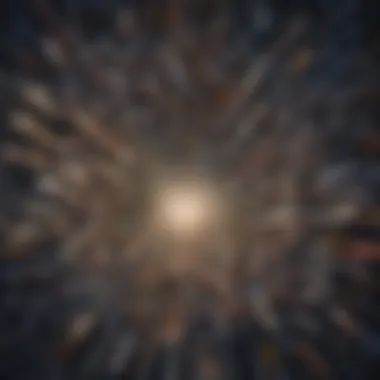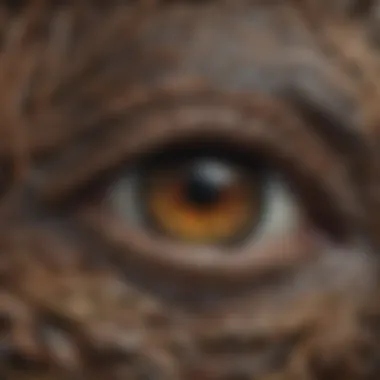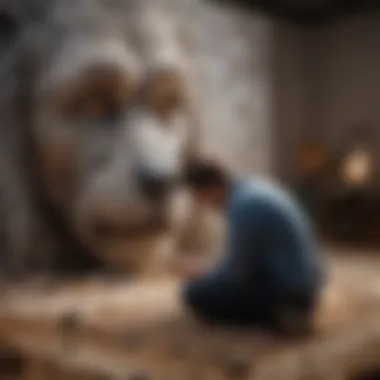The Largest Doodle: Scale and Artistic Expression


Intro
Art exists in many forms, and one of the most intriguing expressions is doodling. Often perceived as casual or simplistic, doodles can transcend their initial appearance to become significant artistic statements. When these doodles reach monumental proportions, they initiate discussions about creativity, scale, and cultural relevance.
The exploration of large-scale doodles provokes a deeper understanding of not only the artwork itself but also its impact on communities, its interaction with space, and its environmental footprint. Here, we begin an investigation into the various facets that make a large doodle not just a seemingly trivial act of drawing but an influential piece of art with a far-reaching significance.
The Significance of Scale in Art
Scale is crucial in understanding the intention behind large doodles. The sheer size of these works can amplify their message, creating an immersive experience for the viewer. Large-scale doodles move beyond the boundaries of traditional canvases, engaging the environment and prompting public interaction. Such artworks inspire reflection on what art can represent in public spaces, enhancing community identity and fostering a shared cultural experience.
Artists have long experimented with scale, and large doodles serve as a conduit between the artist and the public. This dialogue challenges conventions about where and how art can exist, shifting the focus from private galleries to open public spaces.
Creativity in Large Doodles
Creating sizable doodles involves not only artistic skill but also innovation in technique and materials. Artists must consider a broader scope when planning their works, which often involves collaboration with others, including local communities. This collaborative process encourages diverse perspectives and contributes to a more meaningful final product.
Doodling, at its core, is about freedom of expression. Large doodles exemplify this freedom by translating simple sketches into expansive designs. Artists can express complex themes, social commentary, or personal stories through these vast canvases. It is this blend of simplicity and profundity that captivates audiences.
Cultural Impact of Large Doodles
The cultural implications of large doodles are vast. They often reflect societal issues, provoke dialogue, and invite community engagement. Large-scale doodle projects can be catalysts for social change, breaking down barriers and connecting individuals across diverse backgrounds. They can also become landmarks, contributing to the cultural landscape of cities and towns.
“Art is not what you see, but what you make others see.” – Edgar Degas
When communities come together to create art, they forge connections. This collective activity not only beautifies the environment but also strengthens community ties. Furthermore, when communities collaborate in the creation of large doodles, they can also address local concerns or celebrate cultural heritage, making the art reflective of collective identities.
Environmental Considerations
Creating large-scale doodles poses environmental questions. The materials used, ranging from paint to fabric, can have varying impacts on the environment. Artists and communities must consider sustainability when embarking on these projects. Some choose eco-friendly materials, while others focus on temporary installations that minimize long-term environmental impact. The choice of location is also crucial, as artists weigh the potential effects of their work on local ecosystems.
The growing awareness around environmental issues invites artists to rethink their approach to large doodles. In some cases, artists incorporate natural elements into their designs or choose locations that highlight the beauty of nature, creating a harmonious blend of art and environment.
Understanding Doodles
The exploration of doodles serves as the foundation for understanding how art can manifest in diverse forms. It is essential to grasp what doodles encompass, their history, and their cultural significance. Doodles are not mere scribbles; they can convey deep thoughts, feelings, and ideas. Understanding doodles paves the way to further investigate larger scale varieties and their resonance in the art world.
Definition of Doodles
Doodles are spontaneous, unconscious marks made on a surface. They often come to life when a person is engaged in another activity, such as talking on the phone or listening to a lecture. Unlike sketches or intentional drawings, doodles emerge from instinct. This automatic process allows for a unique form of creativity, where the mind breaks free of constraints. They can take various shapes and forms, ranging from abstract designs to recognizable figures. In this article, we delve deeper into their various interpretations and the significance they hold.
History of Doodling
Early examples of doodling
Early examples of doodling have roots in ancient civilizations. Archaeological findings indicate that even primitive cultures engaged in mark-making that resembled doodling. These marks were typically etched on stone or cave walls, which served both practical and artistic purposes. The relationship between doodling and communication is crucial, as it showcases humanity's need to express itself visually.
One key characteristic of these early doodles is their simplicity. They often consisted of basic shapes and lines, easy to reproduce, making them a beneficial choice for communication. Such forms persisted through time, providing a visual language that transcended spoken words. The uniqueness of early doodles lies in their ability to connect cultures. They carried ideas that were easily shared across geographical boundaries, even before written language developed.
The evolution of doodles in art
Over centuries, doodling has evolved. In the modern context, doodles have moved from random acts to recognized artistic expressions. Artists began to see value in these spontaneous marks, incorporating them into formal artworks. This evolution highlights the versatility of doodles and their ability to adapt to different styles.
A key characteristic of this evolution is the transition from innocence to sophistication. Doodles have found their place not just in informal settings, but also in galleries and exhibitions. This acceptance marks doodling as a legitimate form of artistic expression. The unique feature is that doodles can transcend traditional boundaries of art, becoming a voice for the artist. This evolution has expanded the understanding of what art can be, making it a crucial topic in this article.
Notable artists and their doodles
Many renowned artists have utilized doodling as part of their creative process. Pablo Picasso and Joan Miró are examples of artists who embraced doodles, incorporating them into their larger works. Their unique approach allowed them to explore creativity without judgment, leading to groundbreaking art movements.


The significance of notable artists' doodles is profound. These doodles often serve as the initial point of inspiration for their masterpieces, demonstrating how small marks can evolve into significant art. The widespread recognition of artists who doodle has legitimized the practice in the eyes of many. Moreover, it shows how a simple act can yield substantial artistic outcomes. Doodles illustrate the interplay of spontaneity and intention, and their influence on creative thought is notable in this discussion.
Overall, the understanding of doodles is essential for discussing larger-scale doodles. By examining their definition, history, and notable representations, we gain a comprehensive perspective that informs the broader examination of scale and its implications in the art world.
The Concept of Scale in Doodles
The scale of a doodle significantly influences its impact, meaning, and engagement with viewers. Understanding this concept opens new pathways in appreciating art. Scale not only refers to the physical size but also to how the proportions affect interpretation and viewer experience. Large doodles often draw more attention compared to their smaller counterparts. They invite interaction and can even transform a dull space into an artistic statement. Moreover, the scale can change the context in which art is perceived, reinforcing the idea that size matters in the world of doodling.
Why Scale Matters
The importance of scale in doodling lies in its ability to evoke different emotions and reactions. A huge doodle can create a sense of awe. People may marvel at the effort and creativity required to create such an extensive piece. Conversely, smaller doodles might evoke thoughts of intimacy and personal connection. Different scales provoke different responses from audiences, entwining viewers in the story behind the art.
Consider the following factors:
- Visibility: Larger doodles are easier to spot from a distance, making them more likely to gather attention.
- Audience Interaction: Size can encourage viewer engagement. Larger works allow for social interaction, while smaller ones may invite closer examination.
- Contextual Environment: The location often determines how scale is perceived. Doodles on a large wall versus a small sketchbook offer varying experiences.
Comparative Analysis of Small vs.
Large Doodles
When analyzing small and large doodles, both forms offer unique attributes.
Small Doodles
- Personal Touch: Small doodles often seem intimate, representing personal thoughts or moments.
- Accessibility: They can be created anywhere, making doodling a spontaneous activity.
- Detail Work: Artists can focus on intricate designs, using fine lines and small elements.
Large Doodles
- Public Engagement: These can serve as community projects, inviting participation from various individuals.
- Cultural Statements: They often highlight social issues or communal identity through their grand scale.
- Artistic Challenge: Creating a large doodle involves technical skill and meticulous planning, as artists must consider space and method.
Both small and large doodles reveal the versatility of this art form. Each brings value to the creative process, offering distinct insights into the doodler's intent and the audience's response. Understanding these differences enhances appreciation for doodles and their significance within the art world.
The Largest Doodle Examples
The realm of large doodles is filled with unique projects that exemplify creativity at a grand scale. Their significance lies in the intersection of art, community, and culture. Large doodle initiatives engage not only artists but also local communities, inspiring collective creativity. They provide an opportunity to explore how art can transform public spaces and influence community identity.
Case Study: The World’s Largest Doodle
This case study provides insights into a remarkable example of a large doodle that has garnered attention worldwide. Its attributes reveal both logistical considerations and creative processes involved in large-scale art.
Location and dimensions
The world's largest doodle was created in a well-known urban area, spanning a staggering 30,000 square feet. This vast location allowed artists to express their vision without constraint. The specific choice of location offered high visibility, drawing attention from both locals and tourists. This situational context plays a crucial role in maximizing its impact. The sheer size not only emphasizes the scale but also invites viewers to interact from various vantage points.
Materials used
This project employed eco-friendly paints and biodegradable materials. By emphasizing sustainable options, the project sets a precedent in the art community. The advantage of using such materials includes reducing environmental impact and promoting awareness regarding sustainability. These materials also offered durability, allowing the doodle to withstand the elements over time.
Inspiration behind the project
Inspiration stemmed from the community's cultural heritage and local narratives. Artists engaged with residents to gather ideas that resonate deeply with them. This interaction enriched the artistic process, creating a mural reflective of the community's identity. Such a connection enhances the final piece's relevance and significance. The underlying theme bridged artistic expression with local history, making it a valuable addition to public art.
Community Doodle Projects
Community doodle projects serve as a platform for collaboration among diverse groups. They advocate for inclusivity by inviting people of all ages to participate in the creative process. This collective endeavor brings about a sense of ownership and pride within the community.
Collaborative efforts
These projects often involve partnerships among local artists, schools, and organizations. This collaborative approach fosters innovation and diversity in art styles. The participation of various stakeholders multiplies the creativity harnessed in the doodling process. Additionally, it strengthens community ties by involving different demographics and skill levels in creating a shared vision.


Engagement with locals
Engagement with locals is paramount in ensuring that the doodles resonate effectively with intended audiences. Workshops and community meetings often precede the actual doodling. Involving locals in ideation enhances the artistic process significantly. This engagement cultivates ownership and investment, making the doodle more than just an artistic endeavor. It becomes a hallmark of community pride and expression. However, balancing professional artists' vision with public input can present challenges in execution.
Impact on community identity
The imprint that large doodles leave on community identity should not be underestimated. They serve as visual representations of local culture, history, and aspirations. Projects that are embraced by the community often foster pride and a collective sense of belonging. The unique characteristic of these doodles is their ability to provide opportunities for dialogue around identity and inclusivity. When communities see themselves reflected in these works, it uplifts the collective spirit and roots deeper connections.
"Art is not a thing, it is a way." - Elbert Hubbard
Artistic Techniques in Large Doodles
Artistic techniques used in large doodles play a pivotal role in how these artworks come to life. The techniques not only influence the final appearance but also impact the artists' creative process and the viewer's experience. Effective use of tools, materials, and methods can elevate a doodle from mere lines on a wall to a compelling piece of art that invites contemplation and engagement.
Tools and Materials for Large-scale Doodles
Choosing the right tools and materials is critical for creating large-scale doodles. Common materials include chalk, spray paint, markers, and various inks. These choices can affect not only the visual outcome but also the texture and longevity of the work.
For instance, spray paint allows for smooth coverage over large areas and can create gradients that enhance depth. Conversely, chalk offers a temporary solution suited for outdoor spaces where artwork is meant to be ephemeral. Each material carries unique attributes that influence the artist's approach.
Techniques Used in Creating Large Doodles
Planning and layout
Planning and layout are essential for large doodles. This step involves sketching a rough design before actual execution begins. Many artists use grids or projections to ensure the proportions remain accurate when scaling a doodle to a larger surface. This technique minimizes errors that could arise during the creative process.
The key feature of planning is its ability to provide a clear roadmap for artists. This helps maintain consistency in style and feature throughout the artwork. A well-considered layout can lead to better flow and coherence in the finished piece, which is especially important when the size amplifies potential distractions or inconsistencies.
Execution methods
Execution methods refer to how the planned doodle is brought to life on the canvas, wall, or other surfaces. Artists may utilize techniques like stenciling, freehand application, or a mix of both. The choice here is vital; stenciling can provide sharp lines and defined shapes, while freehand offers more organic and fluid representations.
The characteristic of execution methods lies in adaptability. Some artists may choose to adjust their approach based on the surface texture or the presence of obstacles in the environment. This flexibility can be beneficial, but it also poses challenges, as artists must remain vigilant to maintain their original vision while adapting in real-time.
Scale challenges
Scale challenges are inherent when creating large doodles. The sheer size can complicate various aspects, from visibility to access during the creation. Artists face issues such as maintaining the correct proportions, ensuring the overall impact remains effective when viewed from different distances, and handling environmental variables like wind or rain.
One significant characteristic of scale challenges is that they force artists to innovate solutions. For example, they might develop techniques for layering or sectioning the artwork to manage complexity. While these challenges can be daunting, they often result in unique solutions that contribute to the final art piece's narrative and complexity.
The harmonious integration of planning, execution, and addressing scale challenges marks the difference between a simple doodle and a resonant work of art.
Cultural Significance of Large Doodles
Large doodles often carry more than just aesthetic appeal; they serve as a conduit for social interactions, community building, and cultural expressions. The cultural significance of large doodles lies in their unique ability to transform ordinary spaces into vibrant canvases, encouraging people to engage with their environment and each other. This dynamic is particularly vital in public art, where the lines between artist and audience blur, fostering deeper connections and discussions.
Doodles in Public Spaces
Public spaces have always been a canvas for artistic expression. Large doodles stand out, inviting public contemplation and interaction. These creations often serve several purposes:
- Community Involvement: Large doodles can unify diverse groups within a community. Creative sessions invite residents to contribute, creating a shared sense of ownership.
- Place-Making: They transform dull or neglected areas into lively zones. This change often improves the community’s aesthetic and emotional connection to their environment.
- Accessibility: Doodles are often simple yet engaging, making art accessible even to those without a formal background in art.
The Environmental Considerations
Art has a significant impact on our cultural and social landscape, but its environmental implications should not be overlooked. When we consider large doodles and their scale, it is essential to recognize the environmental considerations that arise. Awareness of sustainability in art projects is increasingly relevant in a world facing ecological challenges. Artists, communities, and viewers must ponder how creative expressions can coalesce with ecological responsibility.
Sustainability in Art Projects
Sustainability plays a crucial role in large art projects, including doodles. Artists are encouraged to implement practices that minimize harm to the environment. This approach includes using resources efficiently and considering the life cycle of materials employed.


Some key aspects of sustainability in art include:
- Waste Reduction: Doodlers can aim for less waste by reusing materials and recycling whenever possible.
- Local Sourcing: Utilizing local materials reduces transportation emissions and supports the local economy.
- Temporary Installations: Creating temporary doodles, which may later be removed or repurposed, can significantly reduce long-term environmental impacts.
Adopting these practices fosters creative expression while ensuring that the art does not detract from the planet's well-being.
Eco-Friendly Materials for Doodlers
Choosing the right materials is a critical step in making doodling an environmentally friendly practice. Some eco-friendly options include:
- Plant-Based Inks: Made primarily from natural ingredients, these inks minimize chemical pollution.
- Recycled Papers: Using paper manufactured from post-consumer waste significantly cuts down on need for virgin materials.
- Biodegradable Binding Materials: Opting for glues and tapes that break down naturally helps reduce litter and long-lasting pollutants in the environment.
The transition to eco-friendly materials should consider the potential benefits, such as encouraging more artists to prioritize sustainability, reshaping the art community's overall environmental impact.
"Art has the power to transform spaces, but it is vital that this transformation respects our planet."
The eco-conscious choices made by doodlers can inspire a culture of sustainability in the art world, influencing both emerging and established artists to adopt more responsible practices.
Future of Large Doodles in Art
The exploration of large doodles is not just an artistic journey; it reflects the evolving relationship between art, society, and technology. As we look ahead, several aspects emerge that will guide the future of large-scale doodling. Important elements include the integration of innovative techniques, community involvement, and environmental sustainability. These considerations are essential as artists and communities find fresh ways to express their identities through large artworks.
Emerging Trends
In recent years, there has been a noticeable shift toward more participatory and collaborative doodle projects. Artists increasingly engage local communities in the creation process. This trend allows diverse voices to contribute, enriching the artwork with unique perspectives. Additionally, many artists are embracing mixed media. They combine traditional doodling techniques with painting, graffiti, and digital art.
- The use of bright colors and bold designs continues to attract attention and engage audiences.
Here are some specific trends to watch in large doodles:
- Interactive Elements: Artists are incorporating technology that allows viewers to connect with the artwork. This might include augmented reality or QR codes that lead to more information.
- Public Space Utilization: Greater emphasis is placed on transforming dull urban locations into vibrant canvases. It provides opportunities for both social interaction and cultural expression.
- Doodling Festivals: Community events focus on celebrating doodling as a legitimate form of art, bringing artists and audiences together to create and appreciate art in public spaces.
Potential for Technology Integration
Technology is reshaping the landscape of large-scale doodling. The potential for integration is immense. For instance, digital tools now allow artists to design and plan their large doodles before executing them on-site. This approach significantly enhances precision and creativity in large projects.
Some notable integrations include:
- Digital Sketching Tools: Software like Procreate or Adobe Illustrator enables artists to visualize concepts on a tablet before executing them in larger formats.
- Projection Mapping: Artists utilize projectors to outline their doodles on larger surfaces, making it easier to maintain proportions and alignment.
- Social Media Engagement: Platforms like Instagram and Facebook enable artists to showcase progression in their work, fostering a community of enthusiasts and supporters.
"As technology advances, the method of creating large doodles becomes more intricate and dynamic, inviting wider public participation."
The future of large doodles remains filled with possibilities. The intersection of art and technology not only enhances artistic expression but also creates meaningful public engagement. Doodles are evolving, and so are the avenues they open for community interaction, creativity, and sustainability.
End: Reflecting on the Largest Doodles
The exploration of large doodles reveals their significance in art and culture. Understanding this scale enables an appreciation of creativity, community, and personal expression. Large doodles are not merely grand images; they reflect the interplay between artist and environment, allowing for deeper social engagement.
Summarizing the Importance of Scale and Doodling
The scale of a doodle influences its overall impact. Larger doodles become focal points in public spaces, prompting interaction and conversation. This shift from individual art to communal identity is crucial. It shows how doodling transcends personal enjoyment and evolves into a shared experience. Large doodles can redefine a space, transforming it from ordinary to extraordinary. They provoke thoughts and feelings, making enveryone involved consider art as a dialogue rather than a monologue.
Moreover, large doodles often involve complex planning and collaboration. Artists must think about how their work interacts with the surroundings and audience. The end result is a dynamic piece of art, breathing life into static places.
In addition, these large-scale doodles often ignite discussions about public art and its role in society. They encourage communities to come together, uniting diverse voices, and fostering a sense of belonging. Ultimately, they remind us that art can serve as a bridge between individuals and their environment.
Encouragement for Doodlers and Artists
To artists and doodlers everywhere, do not underestimate the power of your doodles. Whether you are creating on a small notepad or utilizing the entire side of a building, your work matters. Large doodling offers unique opportunities to express ideas and emotions. It can provoke discussion and inspire connections among people of all ages and backgrounds.
Embrace the imperfections in your work. Doodling is not about perfection; it is about expressing thoughts and feelings. Each line can tell a story, and your creativity can influence others.
Consider collaborating with others in your community. Projects involving multiple doodlers can strengthen relationships and build a sense of pride within neighborhoods. Community art can create a lasting impact on public perception of a space. So, take the leap into larger projects. Your creativity has the potential to transform public areas and imbue them with meaning.
Engage with the environment and audience, for they are just as involved in the art-making process. Keep developing skills, experimenting with new techniques, and seeking ways to push your creative boundaries. Together, you can inspire a new era of doodling that resonates deep within communities.







